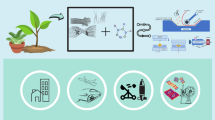Abstract
PVC composites filled with CaCO3 particles with different diameter (about 40, 80, 500, 25000 nm) were prepared by using a single-screw extruder. The mechanical and rheological properties of the composites were investigated. The results showed that while the diameter of CaCO3 nanoparticles was smaller, the mechanical properties of composites were higher. By adding 40-nm CaCO3 nanoparticles into the PVC matrix, the single-notched impact strength of the nanocomposite at room temperature reached 82.4 kJ/m2, which was 3.5 times that of the PVC matrix without CaCO3 (23.3 kJ/m2) and 4.6 times that of the PVC blend filled with micro-CaCO3 (17.9 kJ/m2). The tensile and flexural properties of nanocomposites were also prior to those of the composites with 500-nm and 25-μm CaCO3 particles. The CaCO3 particles could make the rheological property of PVC composites worse. Moreover, the effect of mass ratio of nano-CaCO3 and micro-CaCO3 on the properties of PVC door and window profile in industry was studied. When the mass ratio was 2.5/9, the profile could obtain good mechanical properties.


Similar content being viewed by others
References
Xu WB, Zhou ZF, Ge ML, Pan W-P (2004) J Therm Anal Calorim 78:91
Zheng WG, Lu XH, Wong SC (2004) J Appl Polym Sci 91:2781
Kim BK, Seo JW, Jeong HM (2003) Eur Polym J 39:85
Zheng YP, Zheng Y, Ning RC (2003) Mater Lett 57:2940
Zhang L, Wang ZH, Huang R, Li LB, Zhang XY (2002) J Mater Sci 37:2615
Zhang QX, Yu ZZ, Xie XL, Mai YW (2005) Polymer 45:5985
Bartczak Z, Argon AS, Cohen RE, Weinberg M (1999) Polymer 40:2347
Thio YS, Argon AS, Cohen RE, Weinberg M (2002) Polymer 43:3661
Chan CM, Wu JS, Li JX, Cheung YK (2002) Polymer 43:2981
Wang G, Chen XY, Huang R, Zhang L (2002) J Mater Sci Lett 21:985
Guo ZQ, Chen JF, Zeng XF, Wang GQ, Shao L (2004) J Mater Sci 39:2891
Chen JF, Wang GQ, Zeng XF, Zhao HY, Cao DP, Yun J, Tan CK (2004) J Appl Polym Sci 94:796
Song JR, Shen ZG, Chu GW, Chen JF, Jiao HX (2002) J Beijing Univ Chem Technol 29:5
Acknowledgement
This work was supported by contract grant sponsor: National High Technique Program (“863”) of China; contract grant number: 2005AA302H20.
Author information
Authors and Affiliations
Corresponding author
Rights and permissions
About this article
Cite this article
Zeng, X.F., Wang, W.Y., Wang, G.Q. et al. Influence of the diameter of CaCO3 particles on the mechanical and rheological properties of PVC composites. J Mater Sci 43, 3505–3509 (2008). https://doi.org/10.1007/s10853-008-2475-7
Received:
Accepted:
Published:
Issue Date:
DOI: https://doi.org/10.1007/s10853-008-2475-7




